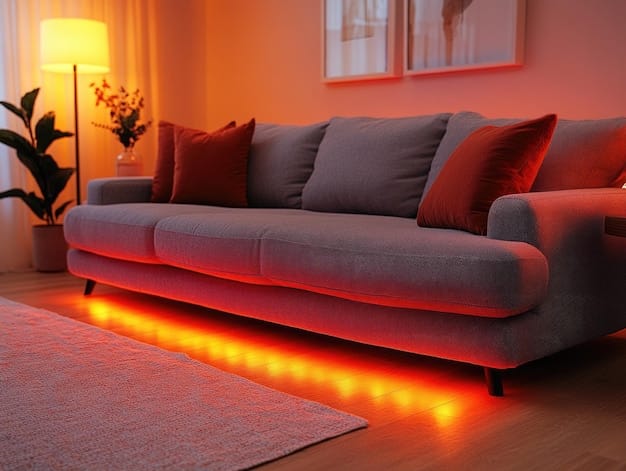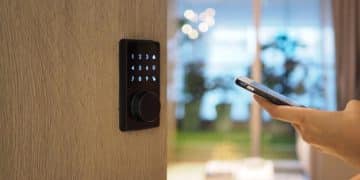Smart Lighting Systems: Brightness, Color & Efficiency Tested

Our review of smart lighting systems examines crucial elements such as brightness, color accuracy, and energy efficiency to assist you in making informed decisions for your smart home.
Upgrading your home with smart technology can significantly improve your living experience. Smart lighting systems reviewed: Brightness, color accuracy, and energy efficiency tested offer a blend of convenience, customization, and energy savings, making them an attractive addition to any modern home.
Understanding Smart Lighting Systems
Smart lighting systems have revolutionized how we illuminate our homes. These systems allow you to control your lights remotely, automate lighting schedules, and even adjust the color and intensity of the light to suit your mood or activities.
Before diving into specific reviews, it’s essential to understand what makes a lighting system “smart.” Smart lighting integrates with your home network, allowing control via smartphone apps, voice assistants, or smart home hubs.
Key Components of Smart Lighting
A smart lighting system typically consists of several components working together harmoniously to provide a seamless user experience.
- Smart Bulbs: These are the core elements, often LED-based, and capable of connecting to your home network.
- Hub or Bridge: Some systems require a hub to communicate between the bulbs and your router.
- Mobile App: This allows you to control the lights, set schedules, and customize settings from your smartphone.
- Voice Assistant Integration: Compatibility with systems like Amazon Alexa, Google Assistant, or Apple HomeKit enables voice control of your lighting.
By understanding these components, you can better assess the capabilities and limitations of different smart lighting systems available on the market.
Brightness and Luminosity: How Much Light Do You Need?
Brightness is a critical factor when evaluating smart lighting systems. Measured in lumens, brightness determines how much light a bulb emits. Different rooms and activities require different levels of brightness.
Choosing the right brightness ensures comfortable and effective lighting for various tasks. A dimly lit bedroom may be perfect for relaxation, while a bright kitchen is essential for cooking.
Recommended Brightness Levels
Understanding the right amount of lumens for different spaces can significantly improve the ambiance and functionality of your home.
- Bedrooms: 400-600 lumens for a relaxing atmosphere.
- Living Rooms: 800-1200 lumens, depending on the size and activities.
- Kitchens: 1200-1600 lumens for adequate task lighting.
- Bathrooms: 800-1000 lumens for general lighting and grooming.
Smart lighting systems often allow you to adjust the brightness, providing flexibility to adapt to different situations. Many systems offer dimming capabilities, enhancing the versatility of the lighting.
Color Accuracy: Achieving the Perfect Ambiance
Color accuracy refers to how well a light source replicates the colors of objects compared to natural sunlight. This is especially important in areas where accurate color representation is necessary, such as art studios or kitchens.
The Color Rendering Index (CRI) is used to measure color accuracy, with a scale from 0 to 100. A higher CRI indicates better color accuracy. For most home applications, a CRI of 80 or higher is recommended.
The Importance of CRI
CRI plays a crucial role in how we perceive the colors around us. A high CRI light source ensures that colors appear vibrant and true to life.
- Accurate Color Perception: High CRI lights show colors as they truly are, making spaces more visually appealing.
- Enhanced Task Lighting: In areas like kitchens, accurate color representation is vital for cooking and food preparation.
- Improved Mood: Natural-looking light can positively impact mood and overall well-being.
Smart lighting systems that offer high CRI values contribute to a more comfortable and visually appealing environment. Some systems allow you to adjust the color temperature, further enhancing the ambiance.
Energy Efficiency: Saving Money and the Environment
Energy efficiency is a key consideration for any lighting system, especially in today’s eco-conscious world. Smart lighting systems, particularly those using LED technology, are known for their energy efficiency.
LED bulbs consume significantly less energy than traditional incandescent bulbs, resulting in lower electricity bills and a reduced carbon footprint. Additionally, features like automated scheduling and dimming contribute to energy savings.
Factors Affecting Energy Consumption
Several factors can influence the energy consumption of your smart lighting system. Being aware of these factors helps you optimize usage and maximize savings.
- Bulb Type: LED bulbs are far more energy-efficient than incandescent or halogen bulbs.
- Usage Patterns: Automating lighting schedules and using dimming features can reduce energy consumption.
- System Efficiency: Some smart lighting systems are inherently more efficient due to better design and technology.
By choosing energy-efficient smart lighting systems and optimizing usage, you can significantly reduce your energy bills and contribute to a greener environment. Many smart bulbs are Energy Star certified, ensuring they meet strict energy efficiency standards.
Integration and Compatibility: Working with Your Smart Home
A crucial aspect of smart lighting systems is their ability to integrate seamlessly with other smart home devices. Compatibility with popular platforms like Amazon Alexa, Google Assistant, and Apple HomeKit is highly desirable.
Integration allows you to control your lights using voice commands, create automated routines, and sync lighting with other smart devices such as thermostats, security systems, and entertainment centers. This holistic approach enhances the overall smart home experience.
Benefits of Smart Home Integration
Integrating your smart lighting system with other smart home devices offers several advantages.
- Voice Control: Control your lights using voice commands through Alexa, Google Assistant, or Siri.
- Automated Routines: Create routines to turn lights on or off based on time of day, motion detection, or other triggers.
- Centralized Control: Manage all your smart home devices from a single app or hub.
When choosing a smart lighting system, ensure it is compatible with your existing smart home ecosystem to avoid compatibility issues. A well-integrated system provides a more convenient and streamlined experience.
User Experience: Ease of Use and Reliability
User experience is paramount when evaluating smart lighting systems. A system that is easy to set up, control, and maintain will provide a more satisfying experience. This includes factors like the intuitiveness of the mobile app, the responsiveness of voice commands, and the reliability of the system.
Reliability is particularly important. A smart lighting system should consistently perform as expected without frequent disconnections or glitches. Poor user experience can negate the benefits of smart lighting, leading to frustration and dissatisfaction.
Factors Affecting User Experience
Several factors contribute to the overall user experience of a smart lighting system.
- Setup Process: The initial setup should be straightforward and hassle-free.
- Mobile App Interface: The app should be intuitive, user-friendly, and offer a comprehensive range of features.
- Voice Control Performance: Voice commands should be recognized accurately and executed promptly.
- System Reliability: The system should operate consistently without frequent disconnections or errors.
Reading user reviews and testing the system yourself can provide valuable insights into the user experience. A well-designed and reliable smart lighting system enhances convenience and enjoyment.
Cost Analysis: Balancing Features and Affordability
Cost is a significant factor for many consumers considering smart lighting systems. While the initial investment may be higher than traditional lighting, the long-term energy savings and added features can justify the expense.
Different smart lighting systems vary in price, depending on the features, brand, and number of bulbs included. It’s essential to balance the features you need with your budget, considering both the upfront cost and the potential energy savings over time.
Factors Affecting Cost
Several factors influence the cost of a smart lighting system.
- Brand Reputation: Established brands often come with a higher price tag but may offer better quality and support.
- Features: Advanced features like color changing, tunable white, and voice control can increase the cost.
- System Size: The number of bulbs and accessories included in the system will impact the overall cost.
By carefully evaluating your lighting needs and considering the long-term benefits, you can find a smart lighting system that fits your budget. Look for systems that offer a balance of features, performance, and affordability.
| Key Point | Brief Description |
|---|---|
| 💡 Brightness Levels | Adjust brightness to suit different rooms and activities. |
| 🌈 Color Accuracy | Choose systems with high CRI for accurate color representation. |
| ⚡ Energy Efficiency | Opt for LED bulbs and automated schedules to save energy. |
| 🏠 Smart Home Integration | Ensure compatibility with your existing smart home ecosystem. |
Frequently Asked Questions (FAQ)
▼
Smart lighting systems offer enhanced convenience, energy savings, and customization options. You can control your lights remotely, automate schedules, and adjust brightness and color to suit your preferences.
▼
Consider the size and purpose of the room. Bedrooms need lower brightness (400-600 lumens), while kitchens and living rooms may require higher levels (800-1600 lumens).
▼
CRI (Color Rendering Index) measures color accuracy. A high CRI (80+) ensures colors appear vibrant and true to life, enhancing the visual appeal and functionality of spaces.
▼
Yes, especially those using LED technology. They consume less energy than traditional bulbs and offer features like dimming and automated scheduling, further reducing energy consumption.
▼
Many smart lighting systems can integrate with platforms like Amazon Alexa, Google Assistant, and Apple HomeKit, allowing voice control and creating automated routines with other smart devices.
Conclusion
Choosing the right smart lighting systems reviewed: brightness, color accuracy, and energy efficiency tested involves careful consideration of your specific needs and preferences. By evaluating factors such as brightness, color accuracy, energy efficiency, integration capabilities, and user experience, you can find a system that enhances your home and improves your quality of life.





